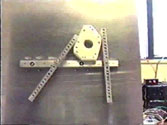
but click
"Dynamic manipulation"
for a cool video
 |
No image available, but click "Dynamic manipulation" for a cool video |
|---|---|
| Quasistatic manipulation | Dynamic manipulation |
Instructor:
Jeff Trinkle
Office:
209b Lally
Email:
trink@cs.rpi.edu
Class Location: Lally 02
Class Time: TF 10:00-11:30
Office Hours: Wednesdays 3:00 - 4:30 or by appointment
Prerequisite: PHYS 1100 and classification as a junior or higher, or permission of the instructor
Goal: One of the most compelling visions in the field of robotics, is the intelligent dexterous robot that can relieve humans of many manual tasks such as folding laundry, framing a house, or repairing a car engine. Unfortunately today's robots are notoriously inept at manipulation tasks - tasks that cannot be done without contact between the robot and moveable objects in the environment. The goal of this course is to develop a fundamental understanding of manipulation through the study of mathematical models of manipulation and algorithms that use these models to plan manipulation tasks.
Text: M.T. Mason, "Mechanics of Robot Manipulation," MIT Press, 2001.
Description:
Manipulate: "To move, arrange, operate, or control by the hands or by mechanical means, especially in a skillful manner." (taken from dictionary.com).
Examples of manipulation include moving, joining, grinding, bending, and reshaping objects. While the first form of manipulation would arguably be the easiest to perform, it is still very difficult for robots. As a result, the majority of manipulation research in robotics still focuses on "simple" tasks that require moving a single nominally rigid object. Therefore, this course will focus on the fundamental concepts of manipulation, including kinematic manipulation, friction, quasi-static manipulation, impact, and dynamic manipulation. We will also study how one can combine the mathematical representations of these concepts with search techniques to yield manipulation planning algorithms.
The concepts covered in this course are also fundamental to physically-based graphics and animation, haptic interaction with virtual worlds, and certain aspects of mechanical design.
Useful LinksAcknowledgements Thanks to Matt Mason for writing the text I'm using for this class and for sharing slides, videos, pictures, notes, and most importantly, his thoughts on the many questions I've asked. Thanks also to Makoto Kaneko, Dan Koditschek, and Ken Salisbury who have provided video clips to illustrate concepts and capture the imaginations of students.